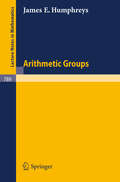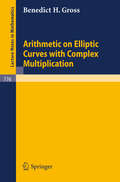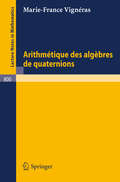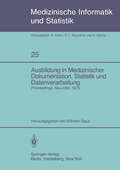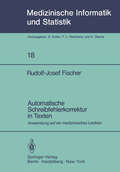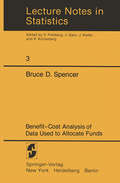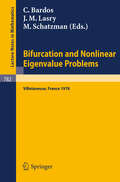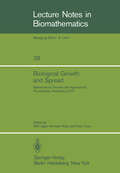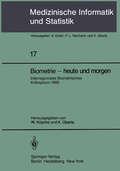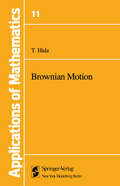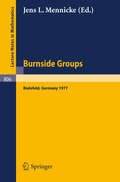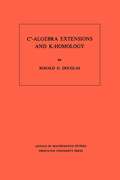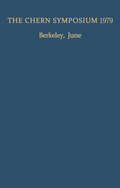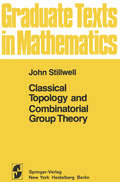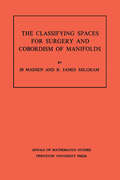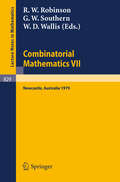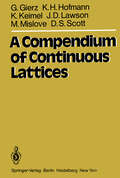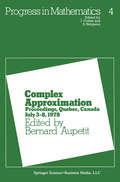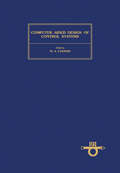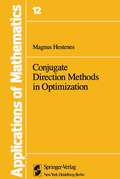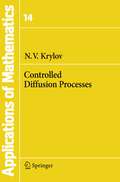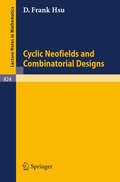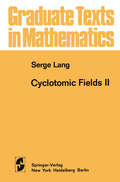- Table View
- List View
Arithmetic on Elliptic Curves with Complex Multiplication (Lecture Notes in Mathematics #776)
by B.H. GrossAusbildung in Medizinischer Dokumentation, Statistik und Datenverarbeitung: Symposium anläßlich des zehnjährigen Bestehens der Schule für Medizinische Dokumentationsassistenten der Universität Ulm, Neu-Ulm, 10. Juli 1979 (Medizinische Informatik, Biometrie und Epidemiologie #25)
by W. GausAutomatische Schreibfehlerkorrektur in Texten: Anwendung auf ein medizinisches Lexikon (Medizinische Informatik, Biometrie und Epidemiologie #18)
by R.-J. FischerBenefit-Cost Analysis of Data Used to Allocate Funds (Lecture Notes in Statistics #3)
by Bruce SpencerThis monograph treats the question of determining how much to spend for the collection and analysis of public data. This difficult problem for government statisticians and policy-makers is likely to become even more pressing in the near future. The approach taken here is to estimate and compare the benefits and costs of alternative data programs. Since data are used in many ways, the benefits are hard to measure. The strategy I have adopted focuses on use of data to determine fund allocations, particularly in the General Revenue Sharing program. General Revenue Sharing is one of the largest allocation programs in the United States. That errors in population counts and other data cause sizable errors in allocation has been much publicized. Here we analyze whether the accuracy of the 1970 census of population and other data used by General Revenue Sharing should be improved. Of course it is too late to change the 1970 census program, but the method and techniques of analysis will apply to future data programs. In partic ular, benefit-cost analyses such as this are necessary for informed decisions about whether the expense of statistical programs is justi fied or not. For example, although a law authorizing a mid-decade census was enacted in 1976, there exists great doubt whether funds will be provided so a census can take place in 1985. (The President's Budget for 1981 allows no money for the mid-decade census, despite the Census Bureau's request for $1. 9 million for planning purposes.
Bifurcation and Nonlinear Eigenvalue Problems: Proceedings, Universite de Paris XIII, Villetaneuse, France, October 2-4, 1978 (Lecture Notes in Mathematics #782)
by C. Bardos J. M. Lasry M. SchatzmanBildhaftigkeit und Organisation: Untersuchungen zu einer differenzierten Organisationshyothese (Reihe 1: Grundlagenforschung und Grundlegende Methodik)
by W. WippichWissenschaftliche Forschungsberichte,Reihe I,Abt.C,Band 80
Biological Growth and Spread: Mathematical Theories and Applications, Proceedings of a Conference Held at Heidelberg, July 16 – 21, 1979 (Lecture Notes in Biomathematics #38)
by W. Jäger H. Rost P. TautuThese Proceedings have been assembled from papers presented at the Conference on Models of Biological Growth and Spread, held at the German Cancer Research Centre Heidelberg and at the Institute of Applied Mathematics of the University of Heidelberg, July 16-21, 1979. The main theme of the conference was the mathematical representation of biolog ical populations with an underlying spatial structure. An important feature of such populations is that they and/or their individual com ponents may interact with each other. Such interactions may be due to external disturbances, internal regulatory factors or a combination of both. Many biological phenomena and processes including embryogenesis, cell growth, chemotaxis, cell adhesion, carcinogenesis, and the spread of an epidemic or of an advantageous gene can be studied in this con text. Thus, problems of particular importance in medicine (human and veterinary), agriculture, ecology, etc. may be taken into consideration and a deeper insight gained by utilizing (more) realistic mathematical models. Since the intrinsic biological mechanisms may differ considerably from each other, a great variety of mathematical approaches, theories and techniques is required. The aims of the conference were (i) To provide an overview of the most important biological aspects. (ii) To survey and analyse possible stochastic and deterministic approaches. (iii) To encourage new research by bringing together mathematicians interested in problems of a biological nature and scientists actively engaged in developing mathematical models in biology.
Biometrie — heute und morgen: Interregionales Biometrisches Kolloquium 1980 der Deutschen Region und Region Österreich — Schweiz der Internationalen Biometrischen Gesellschaft München, 17.–20. März 1980 (Medizinische Informatik, Biometrie und Epidemiologie #17)
by W. Köpcke K. ÜberlaBrownian Motion (Stochastic Modelling and Applied Probability #11)
by T. HidaFollowing the publication of the Japanese edition of this book, several inter esting developments took place in the area. The author wanted to describe some of these, as well as to offer suggestions concerning future problems which he hoped would stimulate readers working in this field. For these reasons, Chapter 8 was added. Apart from the additional chapter and a few minor changes made by the author, this translation closely follows the text of the original Japanese edition. We would like to thank Professor J. L. Doob for his helpful comments on the English edition. T. Hida T. P. Speed v Preface The physical phenomenon described by Robert Brown was the complex and erratic motion of grains of pollen suspended in a liquid. In the many years which have passed since this description, Brownian motion has become an object of study in pure as well as applied mathematics. Even now many of its important properties are being discovered, and doubtless new and useful aspects remain to be discovered. We are getting a more and more intimate understanding of Brownian motion.
Burnside Groups: Proceedings of a Workshop Held at the University of Bielefeld, Germany, June-July 1977 (Lecture Notes in Mathematics #806)
by J. L. MennickeC*-Algebra Extensions and K-Homology. (AM-95), Volume 95 (PDF)
by Ronald G. DouglasRecent developments in diverse areas of mathematics suggest the study of a certain class of extensions of C*-algebras. Here, Ronald Douglas uses methods from homological algebra to study this collection of extensions. He first shows that equivalence classes of the extensions of the compact metrizable space X form an abelian group Ext (X). Second, he shows that the correspondence X ⃗ Ext (X) defines a homotopy invariant covariant functor which can then be used to define a generalized homology theory. Establishing the periodicity of order two, the author shows, following Atiyah, that a concrete realization of K-homology is obtained.
Chancen für das Elektrofahrzeug?: Teil I: Batterien für elektrische Straßenfahrzeuge: Teil II: Elektrizität für den Straßenverkehr? (Energiepolitische Schriftenreihe #6)
by Adolf Neckel Christoph Fabjan Kurt SeldenBereits im Energieplan, den das Bundesministerium für Handel, Gewerbe und Industrie im März 1975 veröffentlicht hat, wurde bei den Möglichkeiten für die Substitution von Energieträgern auf die Elektrotraktion hingewiesen. So heißt es dort im Punkt 18. 2. 3. 3 u. a. : "Im Straßenverkehr in Ballungszentren empfiehlt sich ein erweiterter Ein satz der Elektrotraktion, dem vorläufig durch das ungünstig hohe Lei stungsgewicht der Batterien gewisse Grenzen, vor allem hinsichtlich der Reichweite der Fahrzeuge, gesetzt sind. Verbesserungen werden hier durch die Entwicklung der Zink-Chlorbatterien und später durch den Ein satz von Akkumulatoren mit nicht-wässrigen Elektrolyten erhofft. Nach dem derzeitigen Stand ist nicht anzunehmen, daß der Verbrennungsmotor in den Städten vollkommen substituiert werden kann. Lediglich ein Teil wird auf Elektrotraktion umgestellt werden können . . . . Die Auswirkungen eines erweiterten Einsatzes der Elektrotraktion auf den Ausbau der Er zeugungs-und insbesondere der Verteilungsanlagen für elektrische Energie sind noch eingehend zu prüfen. " Diese Feststellungen stützten sich vornehmlich auf die in Fachpublikatio nen enthaltenen Angaben über Stand und Aussichten der Batterieentwicklung. Diese Angaben waren jedoch teilweise widersprüchlich und in vieler Hin sicht mangelhaft. So wurde es als ein Gebot empfunden, dem Mangel abzuhel fen und die Einschätzung der Chancen der Elektrotraktion auf eine sicherere Basis zu stellen. In dankenswerter Weise hat zunächst das Bundesministerium für Wissenschaft und Forschung durch die Einsetzung eines Projektteams "Elektrochemische Energiespeicherung" eine Bestandsaufnahme nationaler und internationaler Forschungen und Entwicklungen von elektrochemischen Ener giespeichern durchgeführt, deren Ergebnisse von diesem Ressort im Jahr 1976 veröffentlicht wurden.
The Chern Symposium 1979: Proceedings of the International Symposium on Differential Geometry in honor of S.-S. Chern, held in Berkeley, California, June 1979
by M. F. Atiyah R. Bott E. Calabi M. Green P. Griffiths F. Hirzebruch N. H. Kuiper J. Moser L. Nirenberg R. Osserman Wen-Tsün Wu Ning Yang Chen Shing-Tung YanThis volume attests to the vitality of differential geometry as it probes deeper into its internal structure and explores ever widening connections with other subjects in mathematics and physics. To most of us Professor S. S. Chern is modern differential geometry, and we, his students, are grateful to him for leading us to this fertile landscape. The aims of the symposium were to review recent developments in geometry and to expose and explore new areas of research. It was our way of honoring Professor Chern upon the occasion of his official retirement as Professor of Mathematics at the University of California. This book is a record of the scientific events of the symposium and reflects Professor Chern's wide interest and influence. The conference also reflected Professor Chern's personality. It was a serious occasion, active yet relaxed, mixed with gentleness and good humor. We wish him good health, a long life, happiness, and a continuation of his extraordinarily deep and original contributions to mathematics. I. M. Singer Contents Real and Complex Geometry in Four Dimensions M. F. ATIYAH. . . . . . . . . . . . . Equivariant Morse Theory and the Yang-Mills Equation on Riemann Surfaces RAOUL BaTT .. 11 Isometric Families of Kahler Structures EUGENIO CALABI. . 23 Two Applications of Algebraic Geometry to Entire Holomorphic Mappings MARK GREEN AND PHILLIP GRIFFITHS. • . . . • . . 41 The Canonical Map for Certain Hilbert Modular Surfaces F. HIRZEBRUCH . . . . . • . . . . . . . . . 75 Tight Embeddings and Maps. Submanifolds of Geometrical Class Three in EN NICOLAAS H. KUIPER .
Classical Topology and Combinatorial Group Theory (Graduate Texts in Mathematics #72)
by John StillwellIn recent years, many students have been introduced to topology in high school mathematics. Having met the Mobius band, the seven bridges of Konigsberg, Euler's polyhedron formula, and knots, the student is led to expect that these picturesque ideas will come to full flower in university topology courses. What a disappointment "undergraduate topology" proves to be! In most institutions it is either a service course for analysts, on abstract spaces, or else an introduction to homological algebra in which the only geometric activity is the completion of commutative diagrams. Pictures are kept to a minimum, and at the end the student still does not understand the simplest topological facts, such as the reason why knots exist. In my opinion, a well-balanced introduction to topology should stress its intuitive geometric aspect, while admitting the legitimate interest that analysts and algebraists have in the subject. At any rate, this is the aim of the present book. In support of this view, I have followed the historical develop ment where practicable, since it clearly shows the influence of geometric thought at all stages. This is not to claim that topology received its main impetus from geometric recrea. ions like the seven bridges; rather, it resulted from the visualization of problems from other parts of mathematics complex analysis (Riemann), mechanics (poincare), and group theory (Oehn). It is these connections to other parts of mathematics which make topology an important as well as a beautiful subject.
Classifying Spaces for Surgery and Corbordism of Manifolds. (AM-92), Volume 92 (PDF)
by Ib Madsen R. James MilgramBeginning with a general discussion of bordism, Professors Madsen and Milgram present the homotopy theory of the surgery classifying spaces and the classifying spaces for the various required bundle theories. The next part covers more recent work on the maps between these spaces and the properties of the PL and Top characteristic classes, and includes integrality theorems for topological and PL manifolds. Later chapters treat the integral cohomology of BPL and Btop. The authors conclude with a discussion of the PL and topological cobordism rings and a construction of the torsion-free generators.
Combinatorial Mathematics VII: Proceedings of the Seventh Australian Conference on Combinatorial Mathematics, Held at the University of Newcastle, Australia, August 20-24, 1979 (Lecture Notes in Mathematics #829)
by R. W. Robinson G. W. Southern W. D. WallisA Compendium of Continuous Lattices
by G. Gierz K. H. Hofmann K. Keimel J. D. Lawson M. Mislove D. S. ScottA mathematics book with six authors is perhaps a rare enough occurrence to make a reader ask how such a collaboration came about. We begin, therefore, with a few words on how we were brought to the subject over a ten-year period, during part of which time we did not all know each other. We do not intend to write here the history of continuous lattices but rather to explain our own personal involvement. History in a more proper sense is provided by the bibliography and the notes following the sections of the book, as well as by many remarks in the text. A coherent discussion of the content and motivation of the whole study is reserved for the introduction. In October of 1969 Dana Scott was lead by problems of semantics for computer languages to consider more closely partially ordered structures of function spaces. The idea of using partial orderings to correspond to spaces of partially defined functions and functionals had appeared several times earlier in recursive function theory; however, there had not been very sustained interest in structures of continuous functionals. These were the ones Scott saw that he needed. His first insight was to see that - in more modern terminology - the category of algebraic lattices and the (so-called) Scott-continuous functions is cartesian closed.
Complex Approximation: Proceedings, Quebec, Canada July 3–8, 1978 (pdf) (Progress in Mathematics #4)
by B. AupetitComputer Aided Design of Control Systems: Proceedings of the IFAC Symposium, Zürich, Switzerland, 29-31 August 1979
by M. A. CuenodComputer Aided Design of Control Systems focuses on the use of computers to analyze and design the control of various processes, as well as the development of program packages with different algorithms for digital computers. The selection first takes a look at the computer aided design of minimal order controllers, including design of interacting and noninteracting dynamic controllers of minimal order and basic algorithm. The book then discusses an accelerated Newton process to solve Riccati equation through matrix sign function; suboptimal direct digital control of a trickle-bed absorption column; and structural design of large systems employing a geometric approach. The text underscores the computer as an aid for the implementation of advanced control algorithms on physical processes and analysis of direct control algorithms and their parallel realization. Topics include hardware influences on the control, process influence, and interactive structure design of direct control systems. The book also takes a look at the optimal control of randomly sampled linear stochastic systems; computer aided design of suboptimal test signals for system identification; and computer aided design of multi-level systems with prescribed structure and control constraints. The selection is a dependable source of data for readers interested in the uses of computers.
Conjugate Direction Methods in Optimization (Stochastic Modelling and Applied Probability #12)
by M.R. HestenesShortly after the end of World War II high-speed digital computing machines were being developed. It was clear that the mathematical aspects of com putation needed to be reexamined in order to make efficient use of high-speed digital computers for mathematical computations. Accordingly, under the leadership of Min a Rees, John Curtiss, and others, an Institute for Numerical Analysis was set up at the University of California at Los Angeles under the sponsorship of the National Bureau of Standards. A similar institute was formed at the National Bureau of Standards in Washington, D. C. In 1949 J. Barkeley Rosser became Director of the group at UCLA for a period of two years. During this period we organized a seminar on the study of solu tions of simultaneous linear equations and on the determination of eigen values. G. Forsythe, W. Karush, C. Lanczos, T. Motzkin, L. J. Paige, and others attended this seminar. We discovered, for example, that even Gaus sian elimination was not well understood from a machine point of view and that no effective machine oriented elimination algorithm had been developed. During this period Lanczos developed his three-term relationship and I had the good fortune of suggesting the method of conjugate gradients. We dis covered afterward that the basic ideas underlying the two procedures are essentially the same. The concept of conjugacy was not new to me. In a joint paper with G. D.
Controlled Diffusion Processes (Stochastic Modelling and Applied Probability #14)
by N. V. KrylovStochastic control theory is a relatively young branch of mathematics. The beginning of its intensive development falls in the late 1950s and early 1960s. ~urin~ that period an extensive literature appeared on optimal stochastic control using the quadratic performance criterion (see references in Wonham [76]). At the same time, Girsanov [25] and Howard [26] made the first steps in constructing a general theory, based on Bellman's technique of dynamic programming, developed by him somewhat earlier [4]. Two types of engineering problems engendered two different parts of stochastic control theory. Problems of the first type are associated with multistep decision making in discrete time, and are treated in the theory of discrete stochastic dynamic programming. For more on this theory, we note in addition to the work of Howard and Bellman, mentioned above, the books by Derman [8], Mine and Osaki [55], and Dynkin and Yushkevich [12]. Another class of engineering problems which encouraged the development of the theory of stochastic control involves time continuous control of a dynamic system in the presence of random noise. The case where the system is described by a differential equation and the noise is modeled as a time continuous random process is the core of the optimal control theory of diffusion processes. This book deals with this latter theory.
